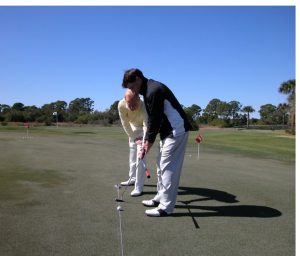Learn Golf from Pieces to Patterns

By Dr. T. J. Tomasi, Keiser University College of Golf Senior Faculty and Director of Research
The general stages you go through to learn golf are similar to other sports because all motor learning progresses by using the same nuts and bolts in repetition:
(a) decide which movements you need to learn (for example, setup, backswing, etc.)
(b) choose the order to learn them – (for example, first grip, then stance, then…)
(c) mimic each movement one at a time as perfectly as you can, checking your progress by using some combination of teacher feedback, video, a mirror, and slow-motion swings mixed with stop action at key junctures along the way.
(d) when you have all the essential pieces learned and repeatable, it’s time to focus on the overall form of the swing (the pattern), which you repeat until all the pieces fall into the correct sequence.
Subconscious sequencing is what your brain does for a living, so you don’t have to get involved other than following the process outlined above. Thus, the three key stages for you as a learner are from (1) pieces to (2) patterns to [3] sequence.
This fairly summarizes your journey from unconscious incompetence, where you don’t even know what swing pieces you need; to conscious incompetence, where you know the pieces you need but don’t have them in house; to conscience competence, where you have learned each of the pieces, but they lack a seamless sequence; to unconscious competence where you can execute the whole swing pattern without thinking about the pieces due to the rule of the sequence. You can focus on the target (out there) vs. the swing (in there) at this stage.
The Rule of the Sequence:
An 800-pound boulder teetering precariously at the top of the mountain has much potential energy waiting to be unleashed and can be ignited by the humblest of triggers. For example, the nudge of a child’s hand can send it hurdling down the slope. And it is the same with your golf swing – the trigger does not have to be powerful to create power; it merely needs ignition capability, and then the sequence does the rest.
In my experience, learners progress fastest when expert feedback is available at critical junctures – this is called knowledge of performance (KOP), and it is where a good teacher comes in. Of course, it is possible to learn golf using only the feedback from the ball flight by deciding, “Okay, I sliced it, so now I’m going to change something until I don’t slice it,” but this is a slippery slope. The danger is that before you figure it out, you’ll hit so many slices that you’ve learned how to slice really well, making it much harder to change later on, even if you find a good teacher.
Takeaway: I advise finding a teacher who understands how humans learn and has arranged their teaching model accordingly. Use the above template for your instructor choice, and you are well on the way to better golf.

This young player is posing a stop-action position 1/2 way into the backswing. I will help her modify it, so she is not so flat, then repeat the change until it becomes part of her mechanics. I often use video and a mirror in addition to the stop-and-pose method.

This pro has already learned his swing, but he can benefit from certain teaching aids I carry in my bag. Here I’m using a string that will teach him to operate the putter using only his shoulders to take the putter back directly back along the string. Quiet is King here.
If you’d like to study with Bradley Turner and other PGA Master Professionals, contact the College of Golf today.














